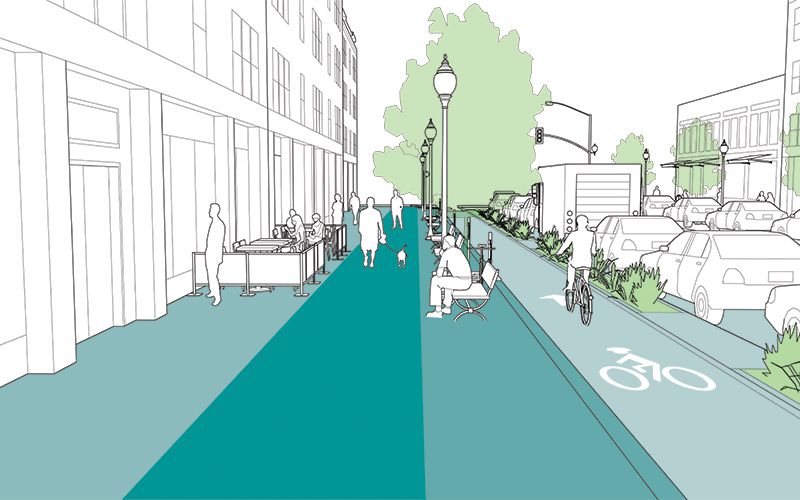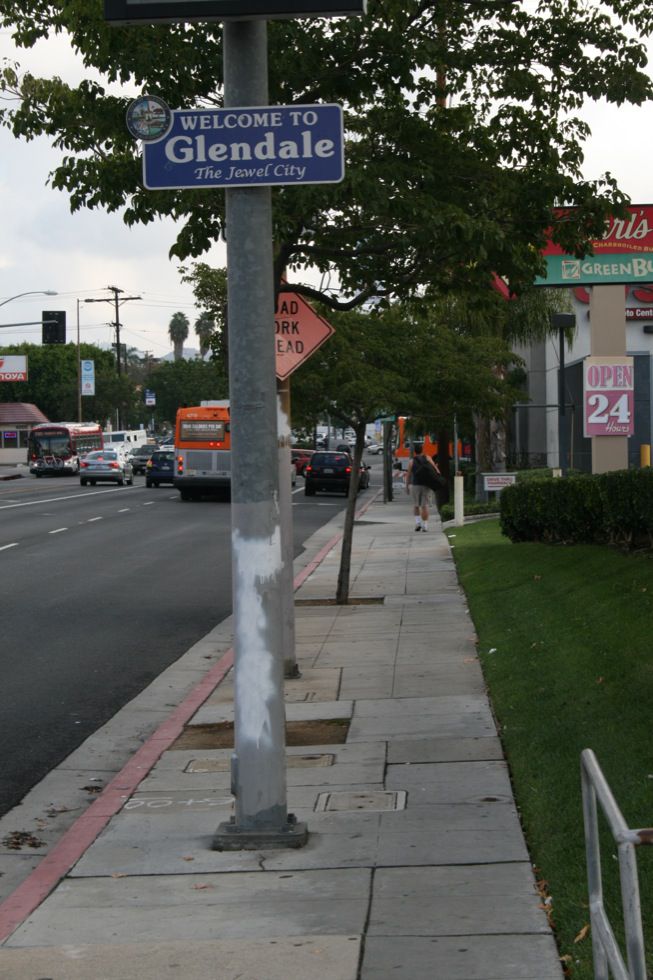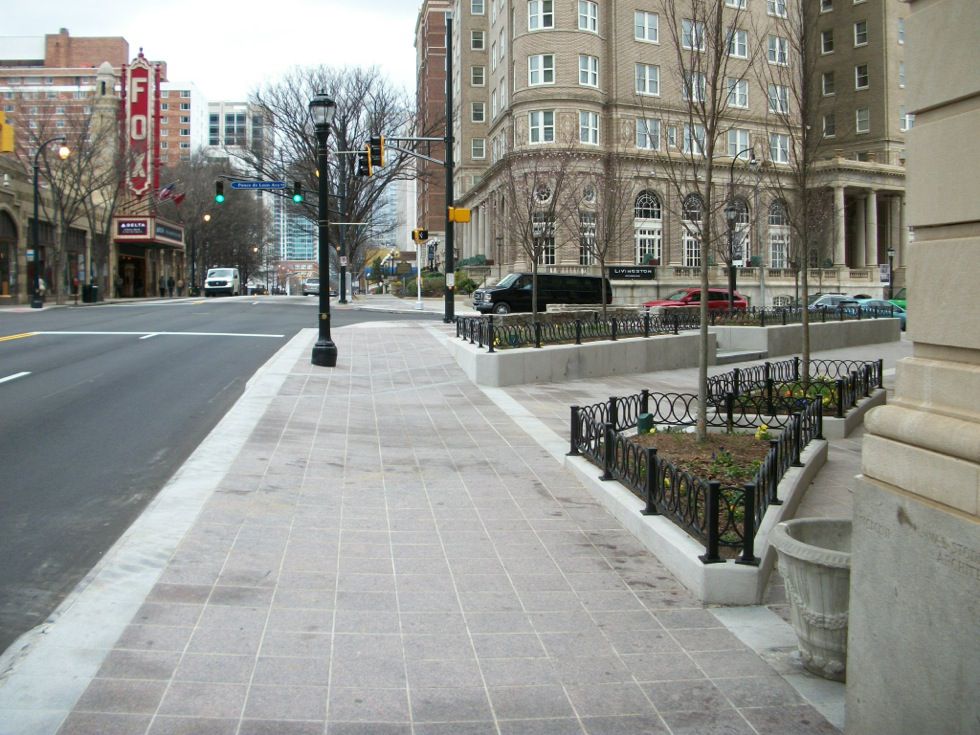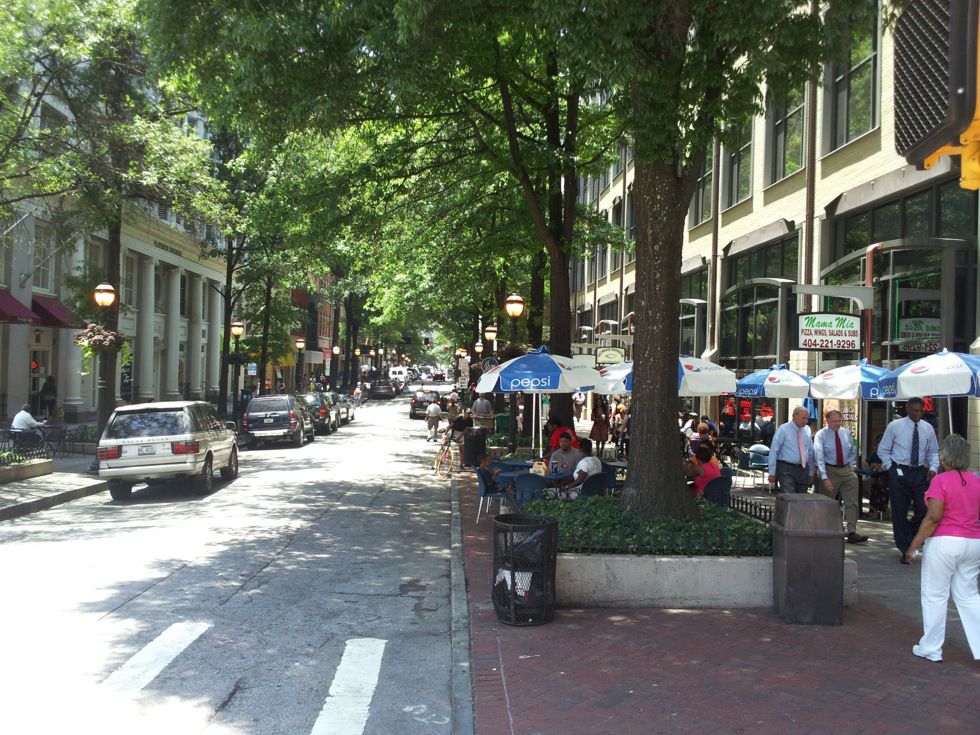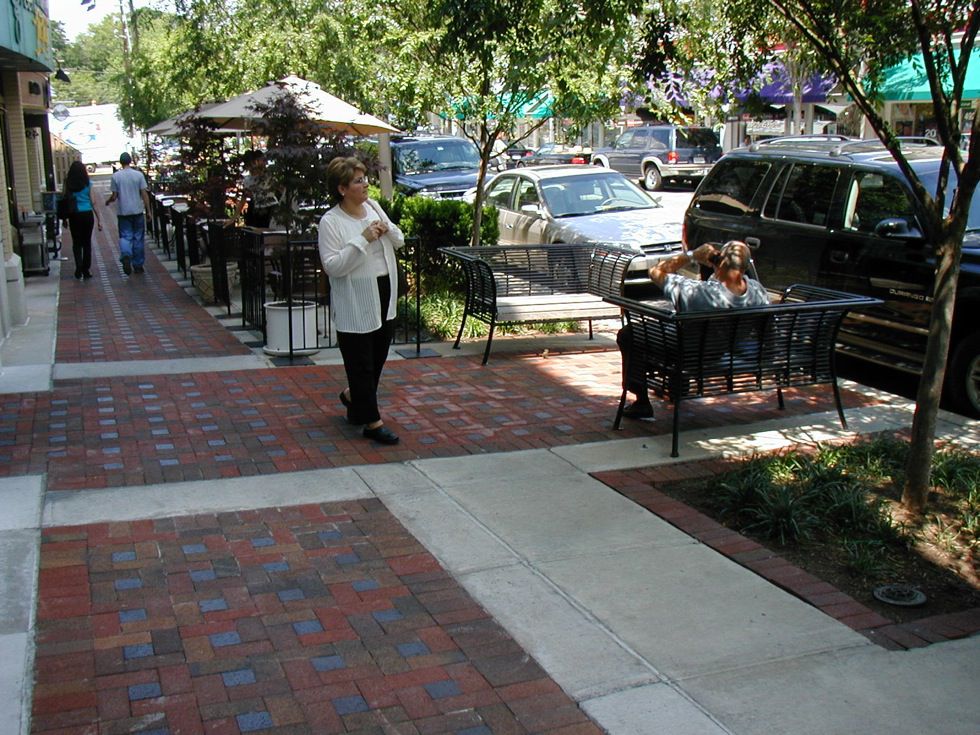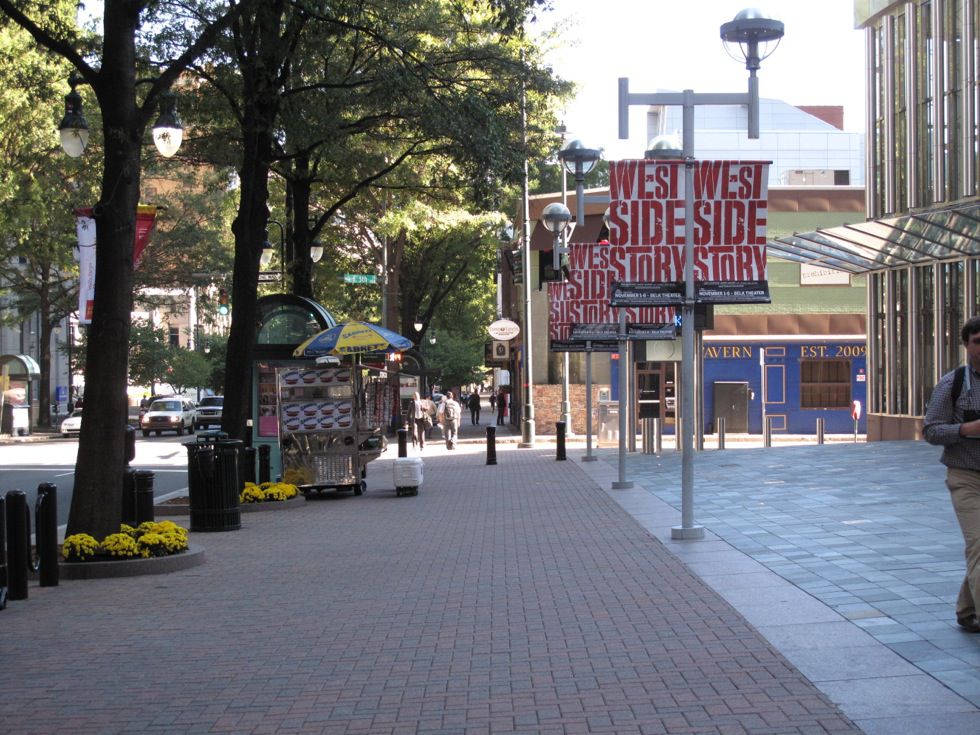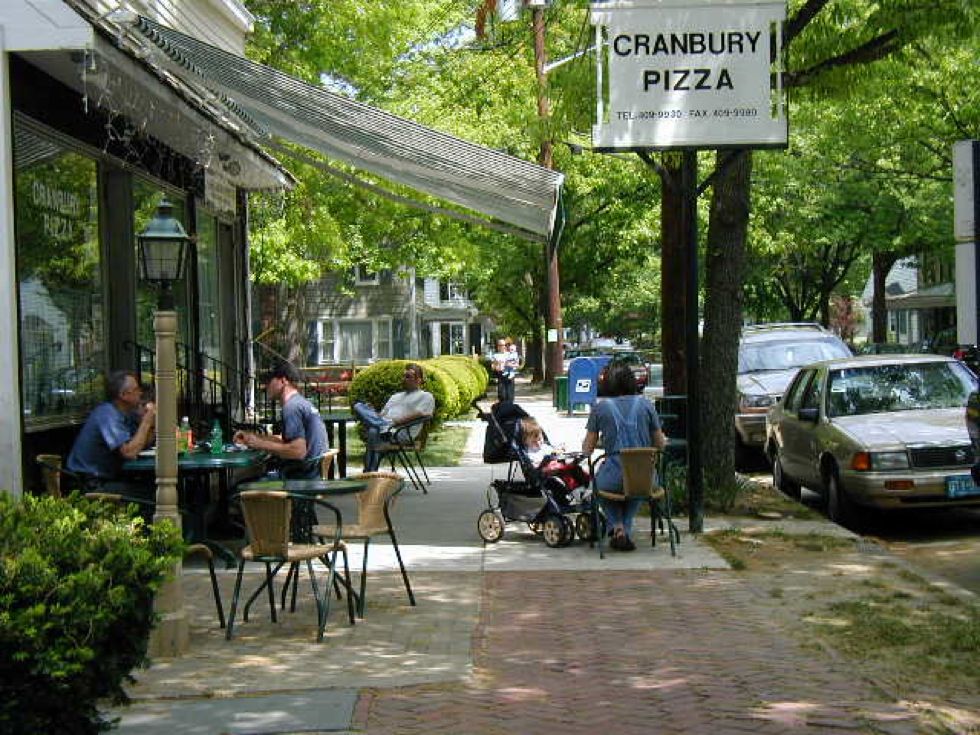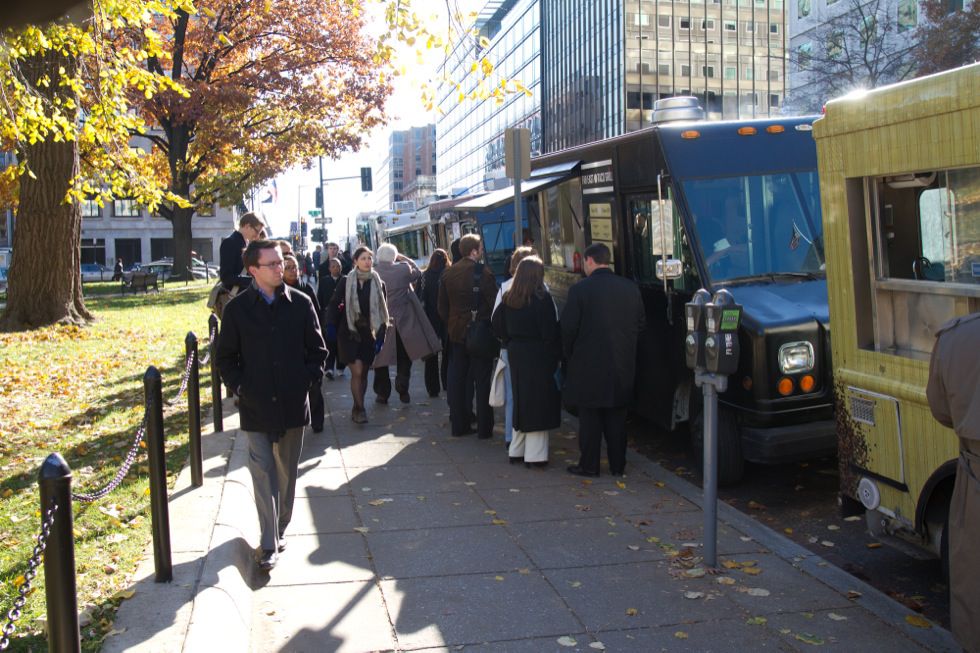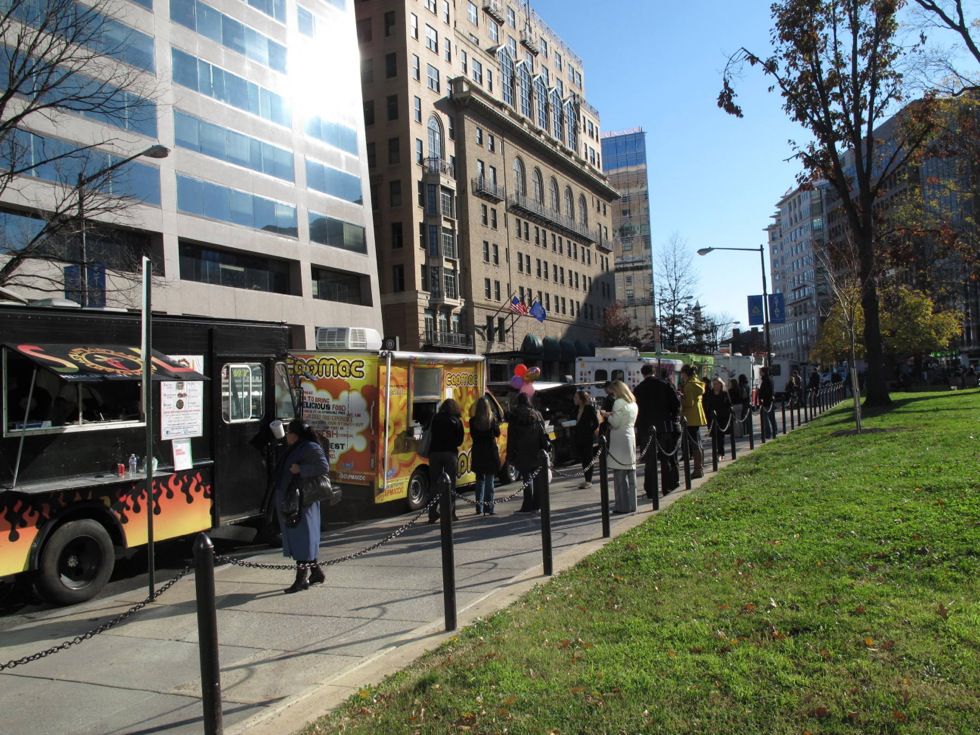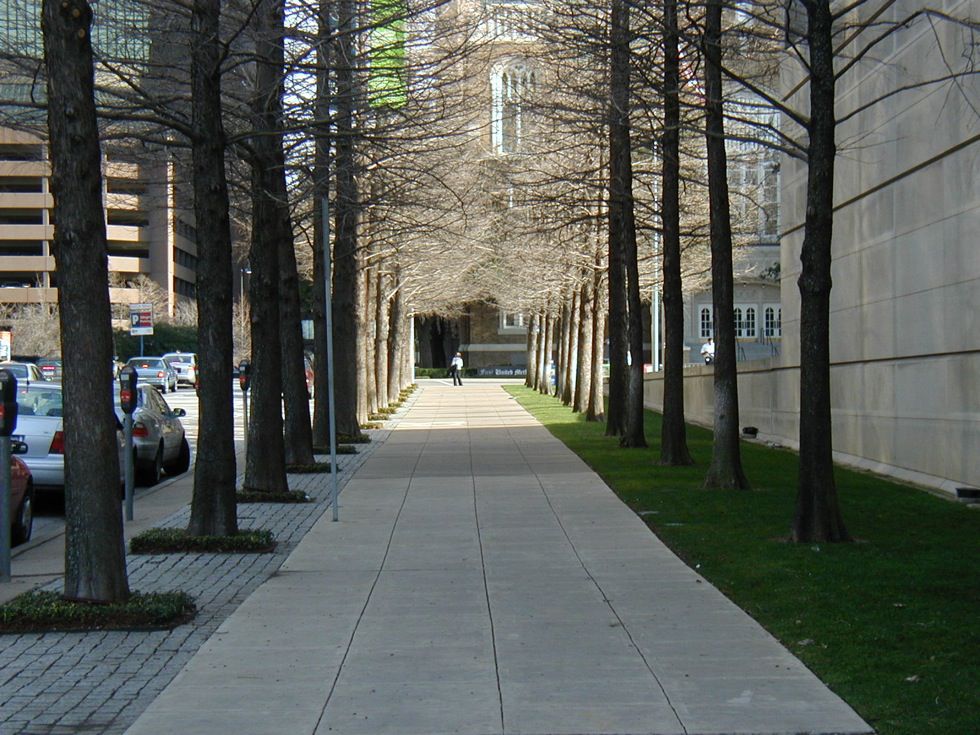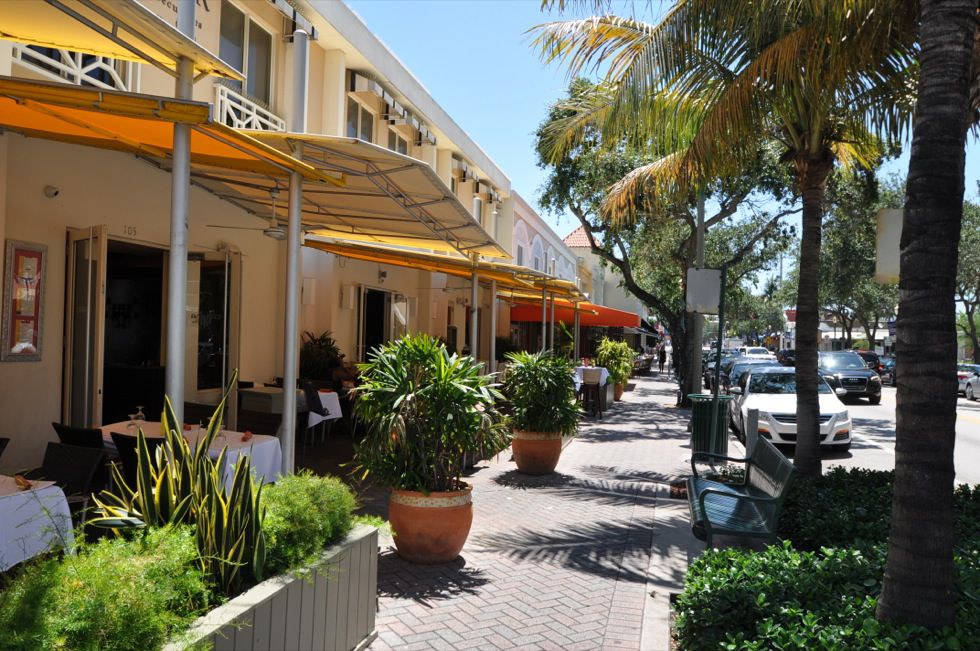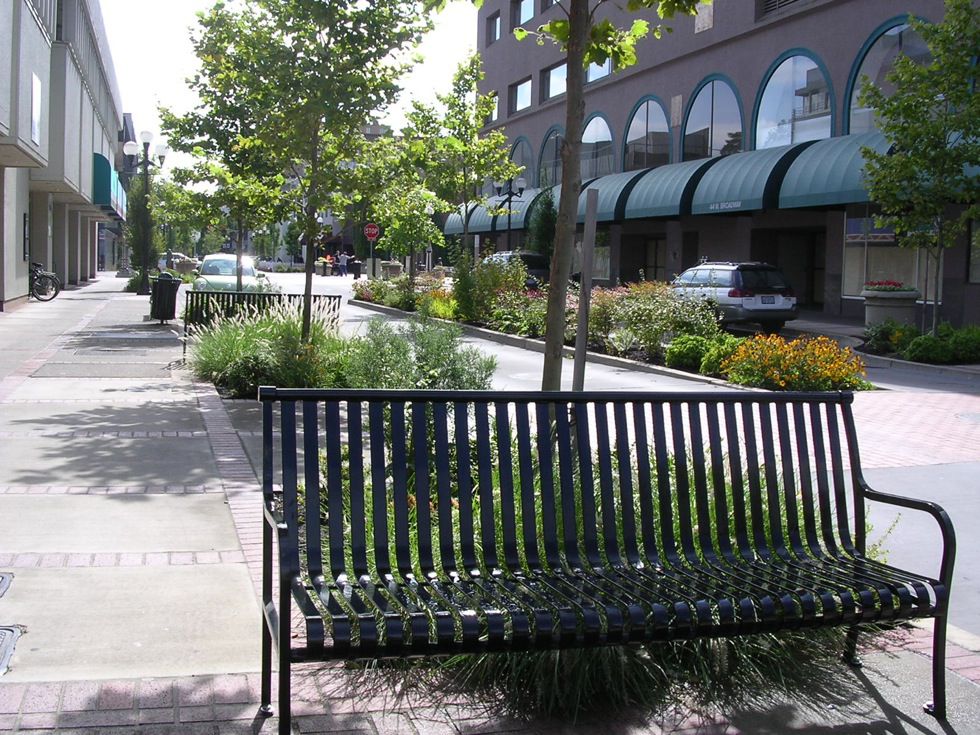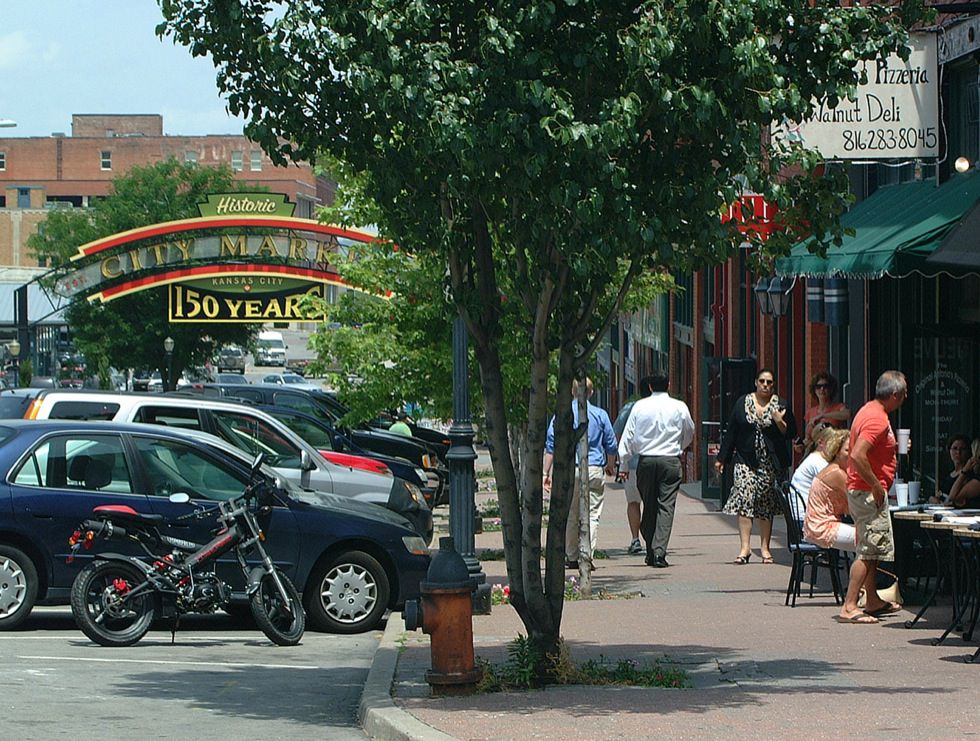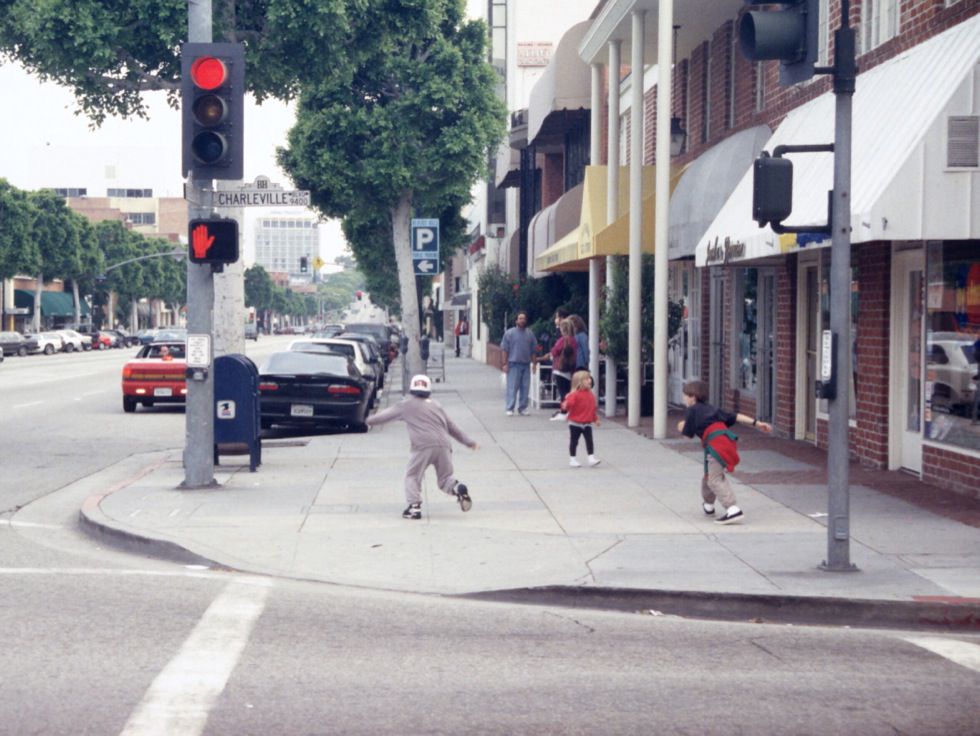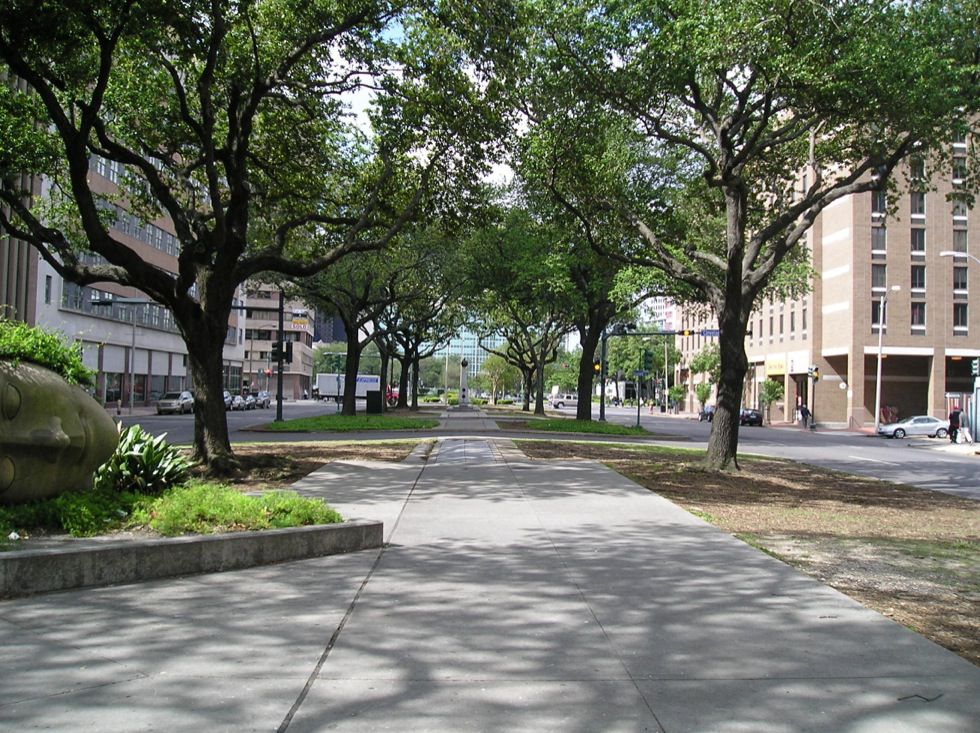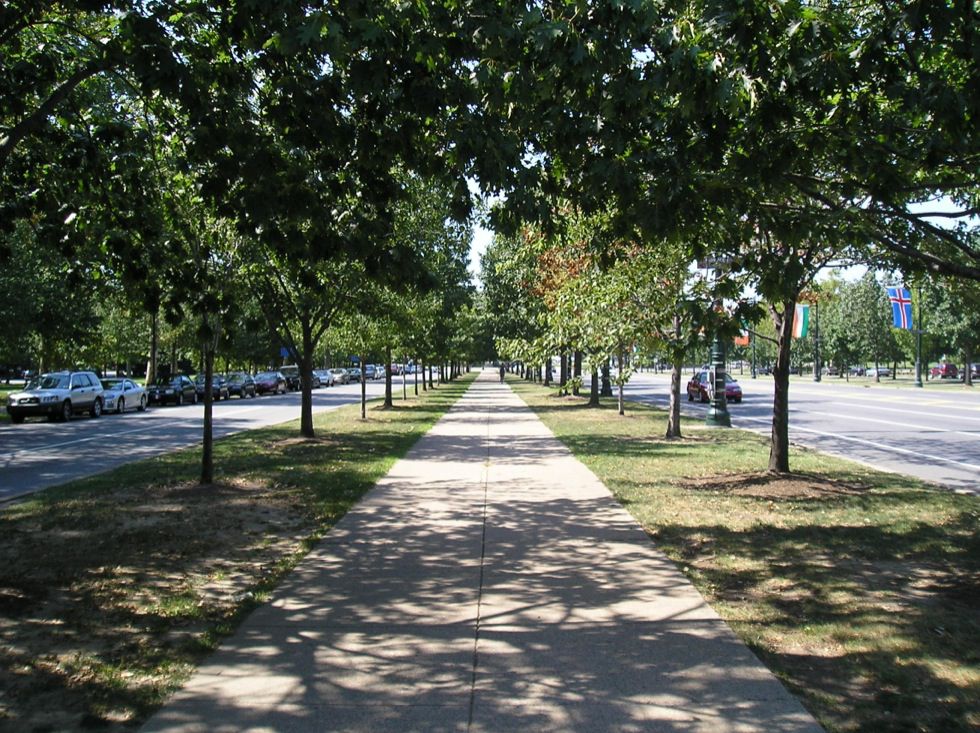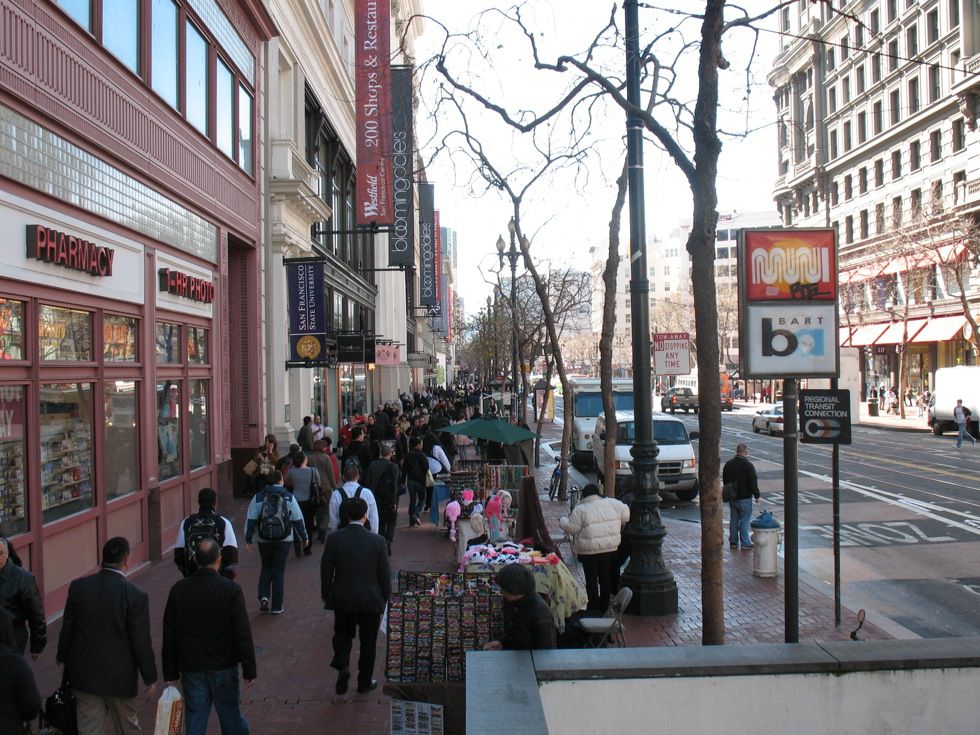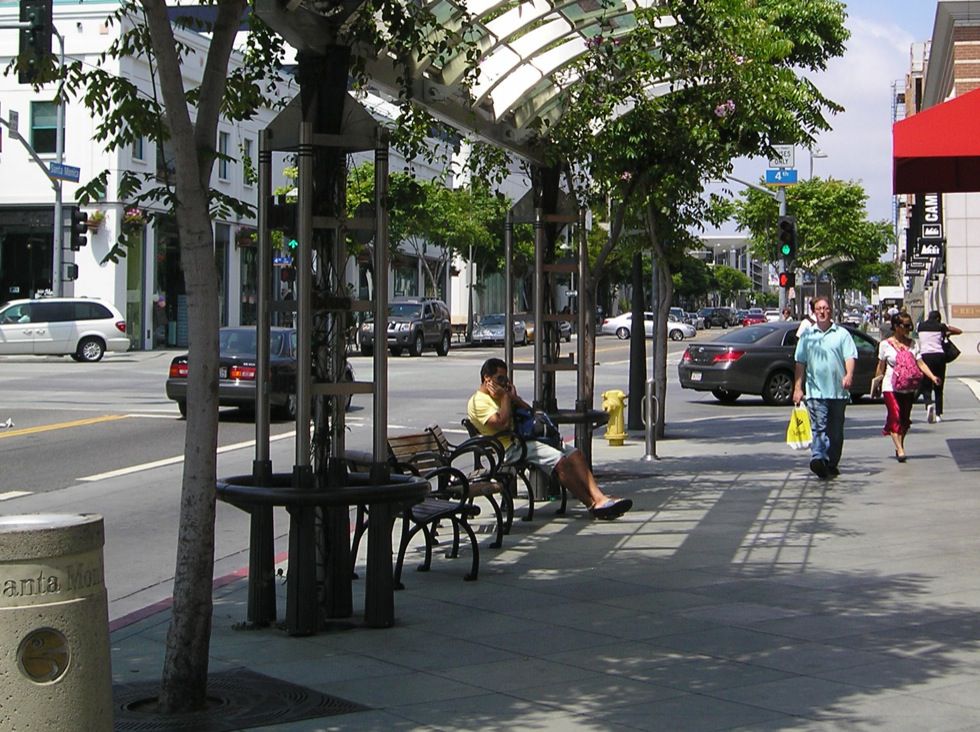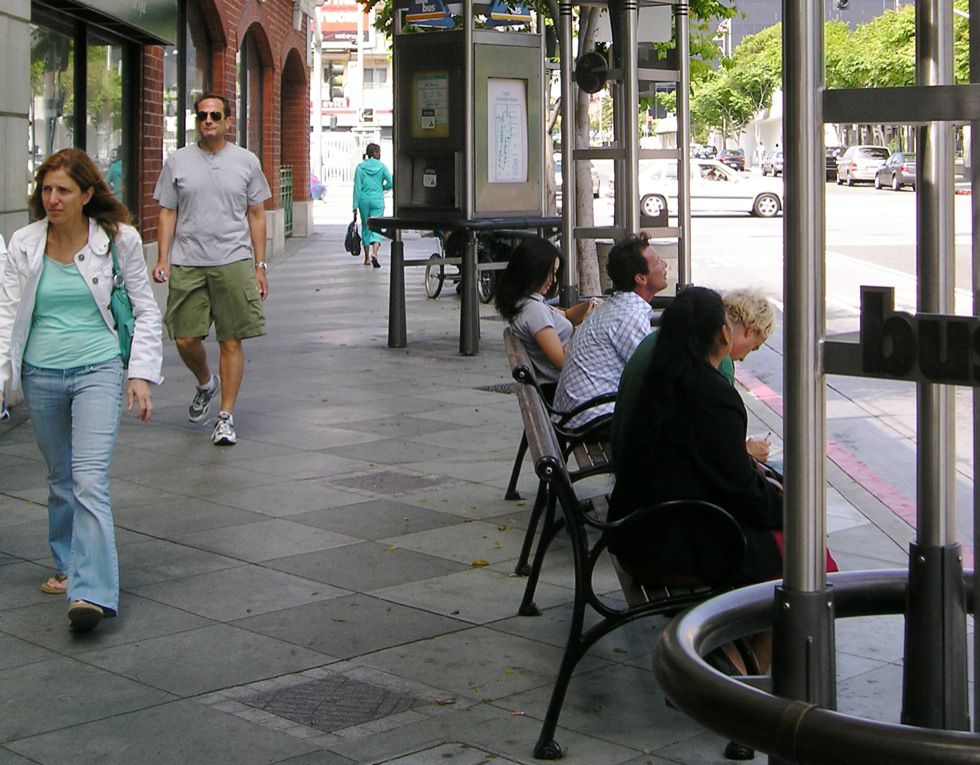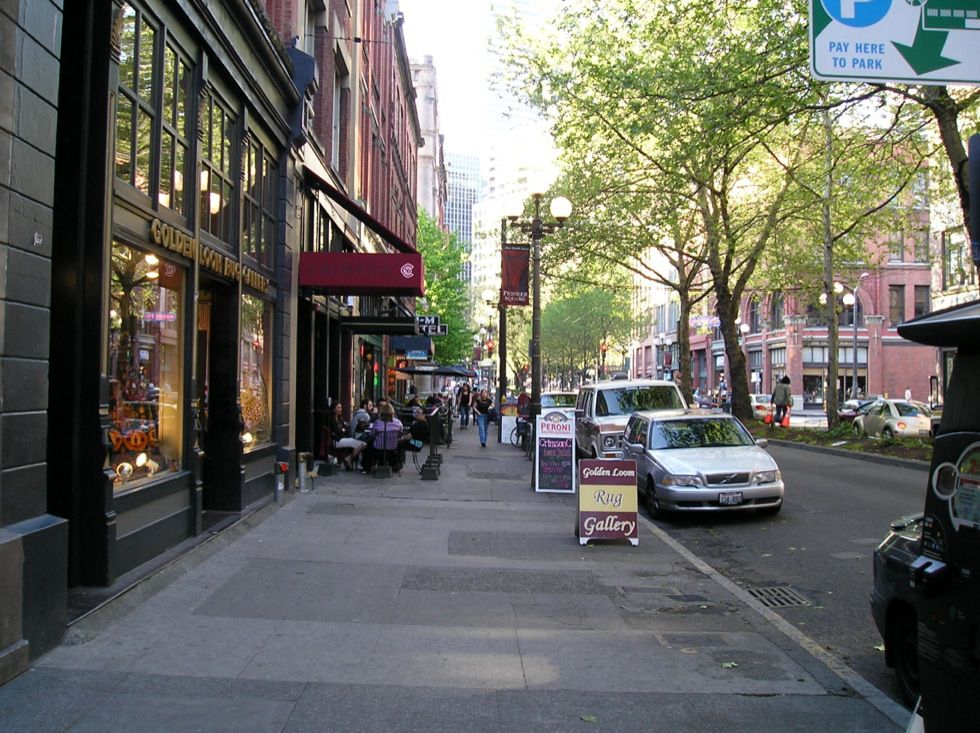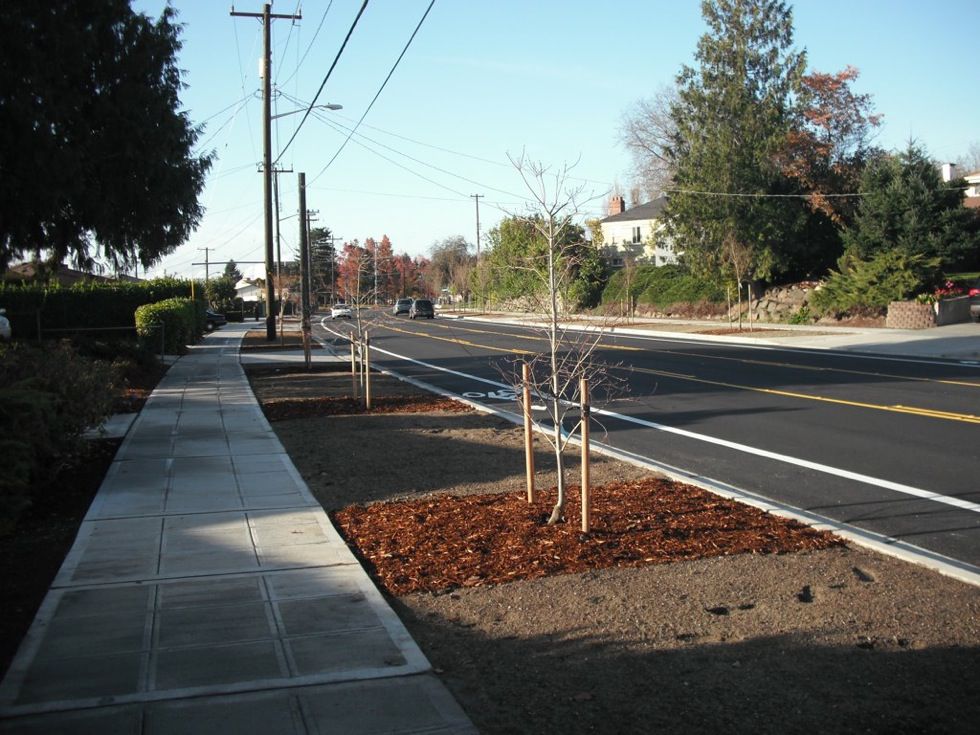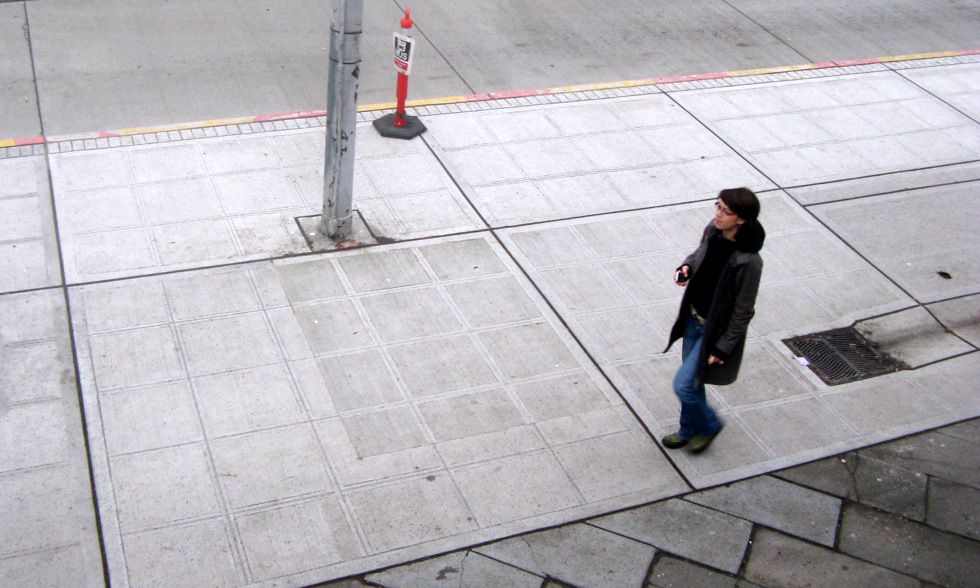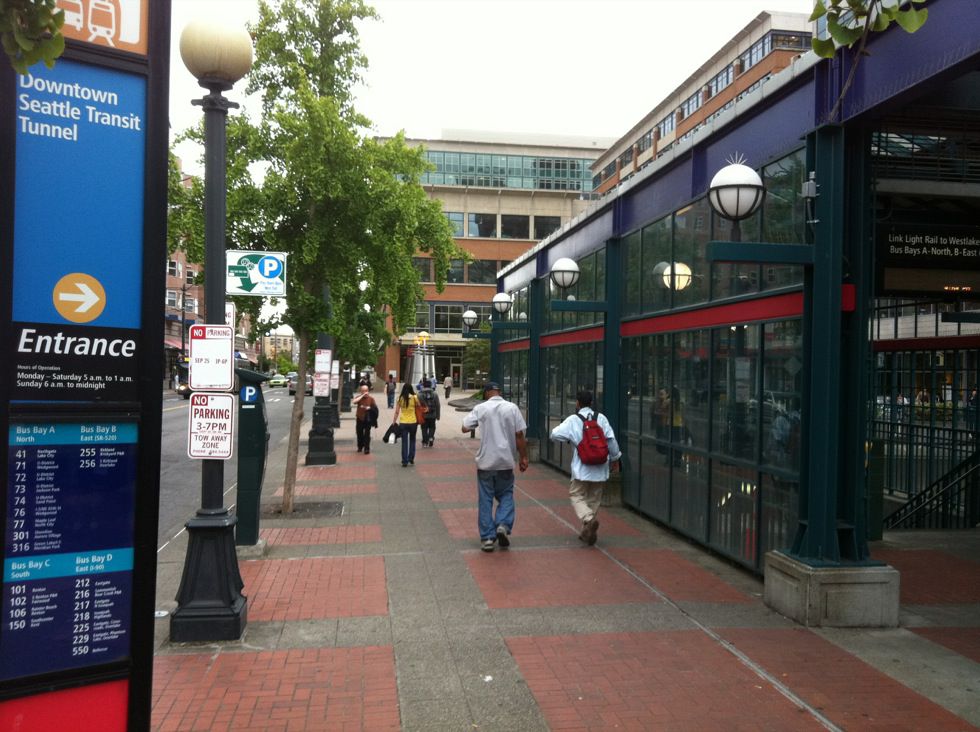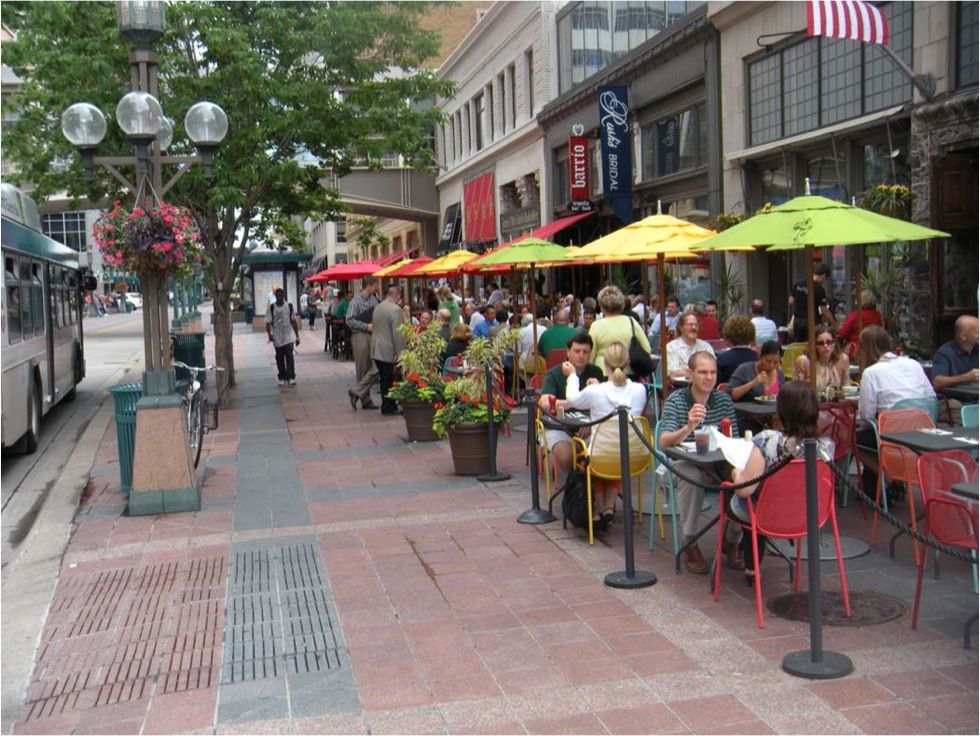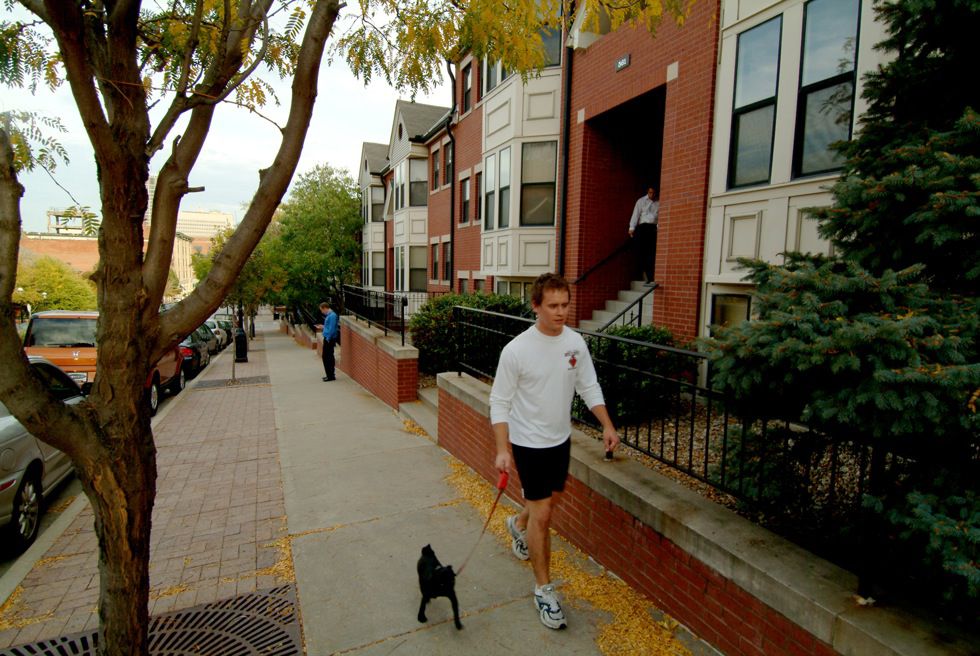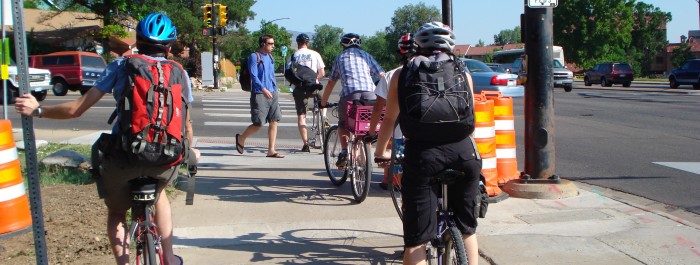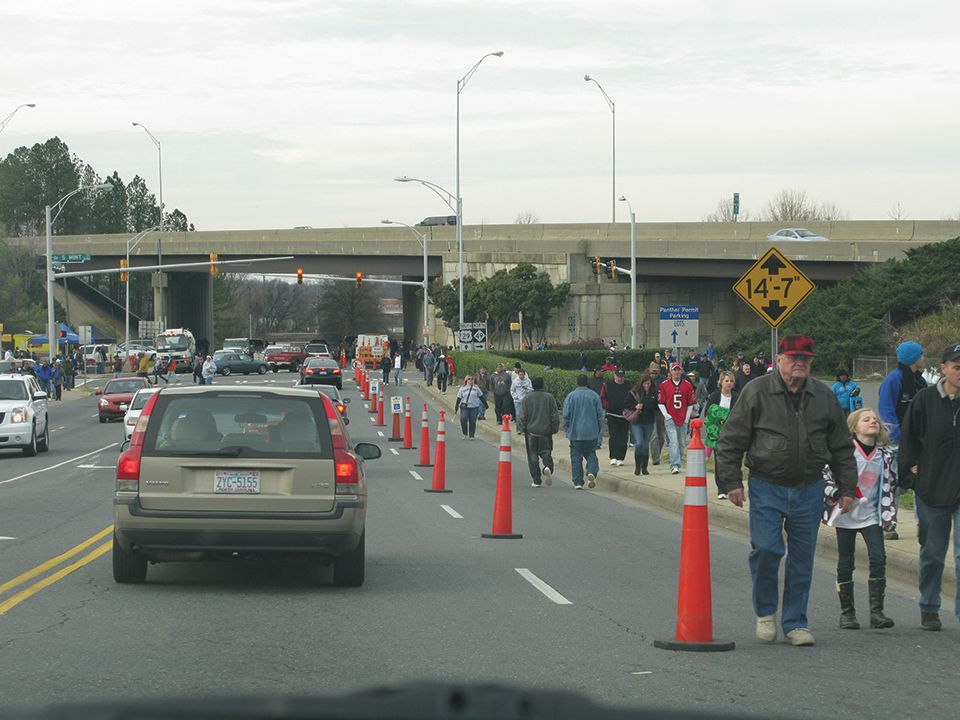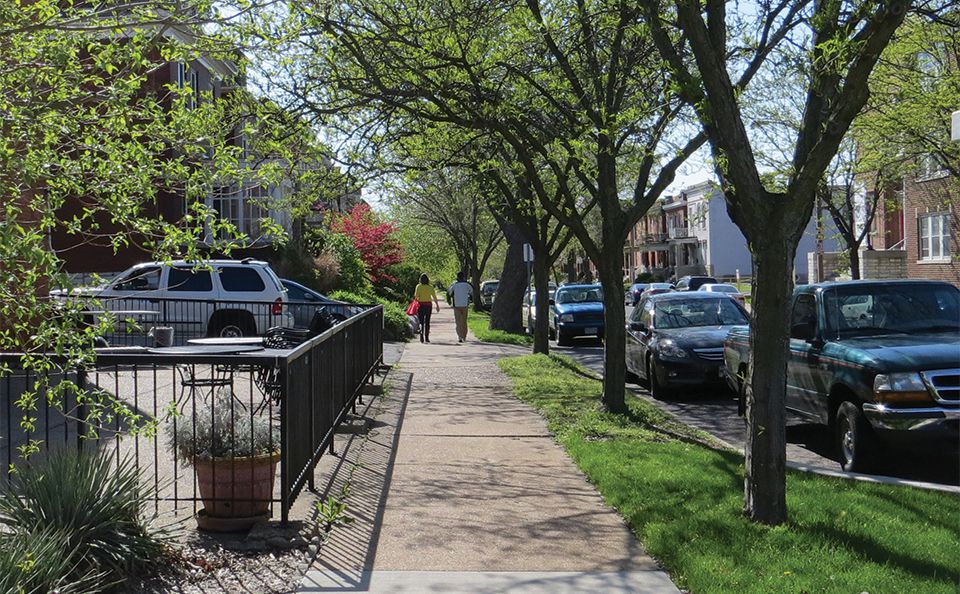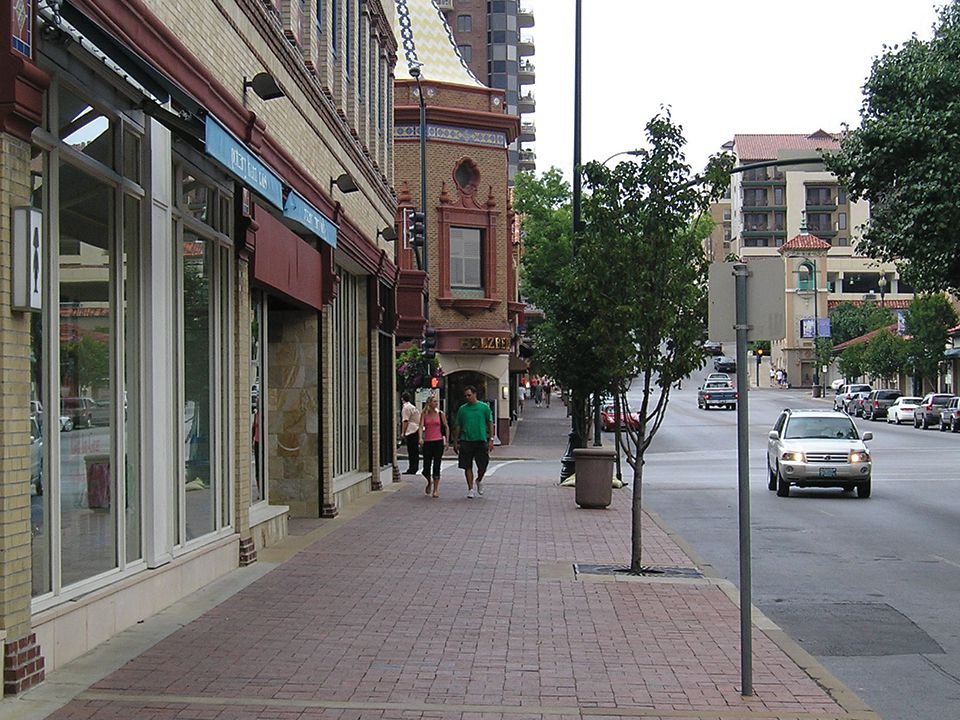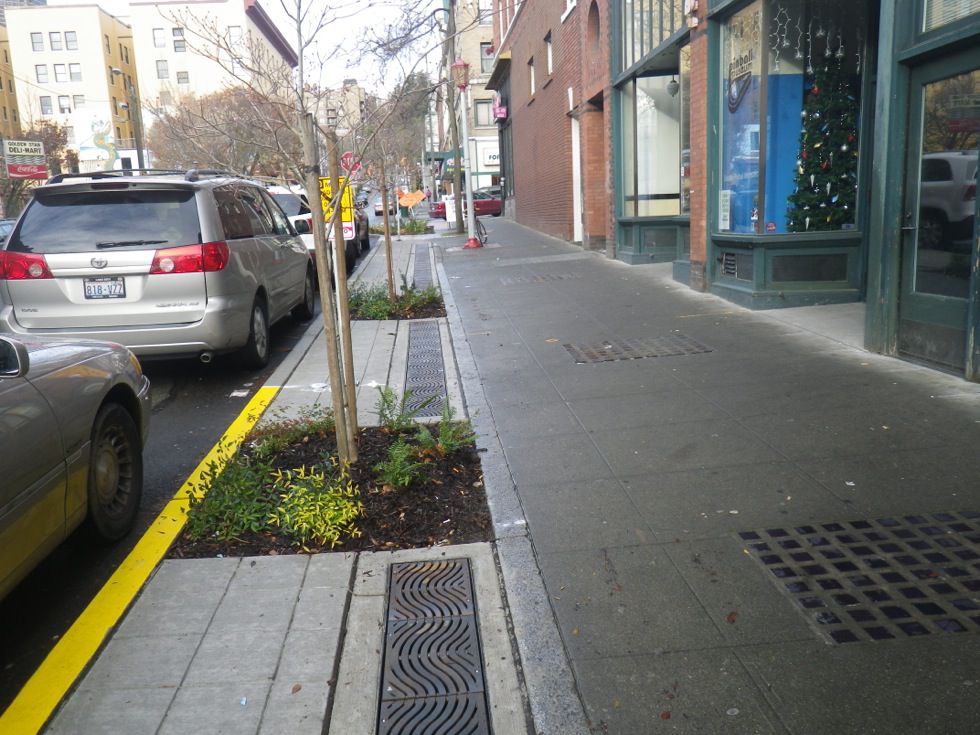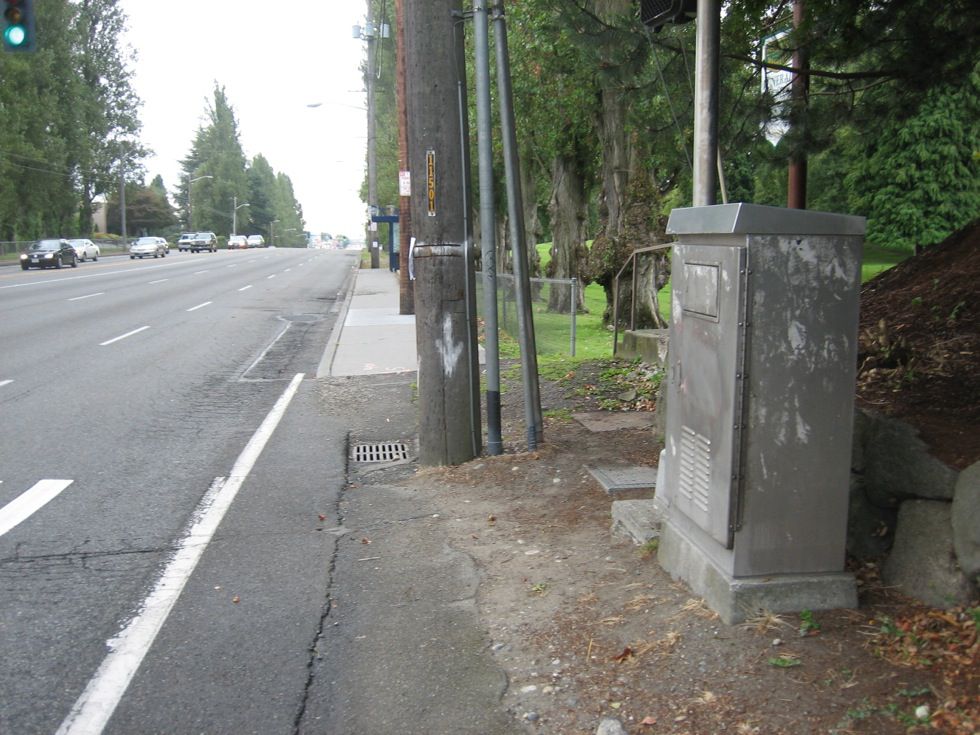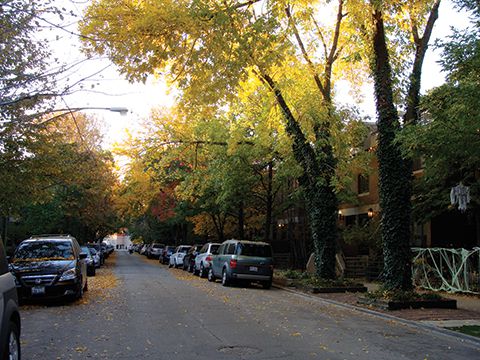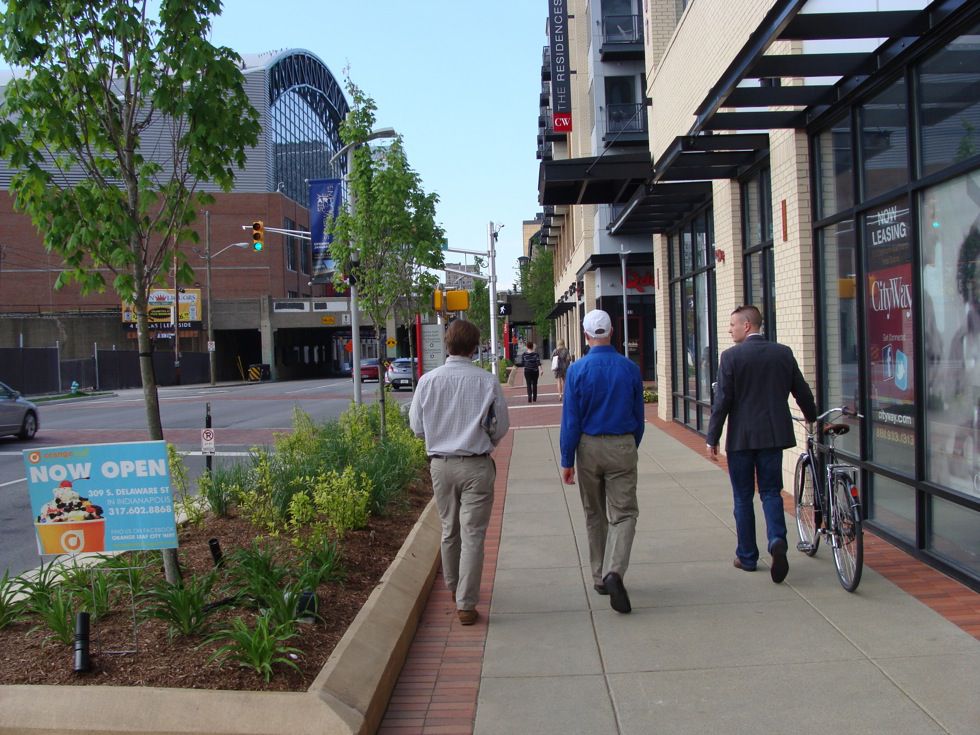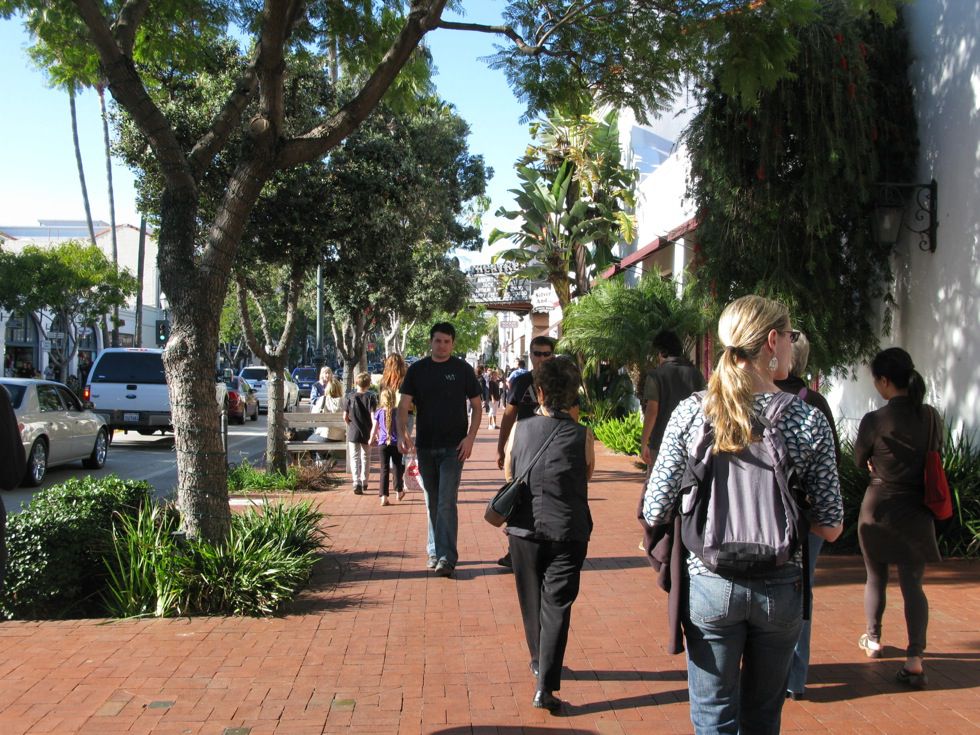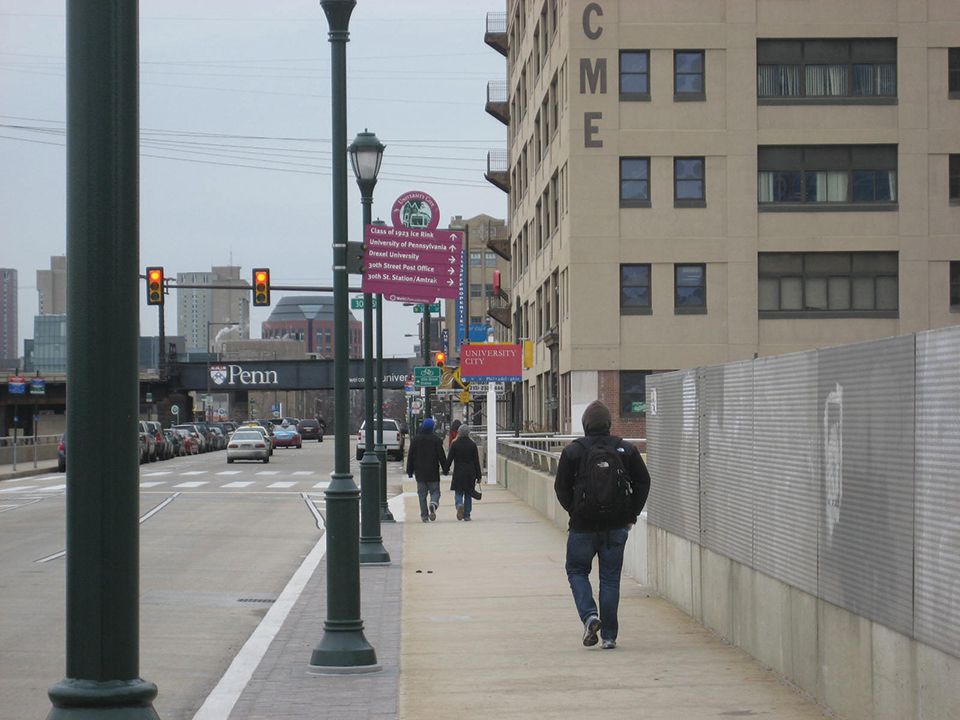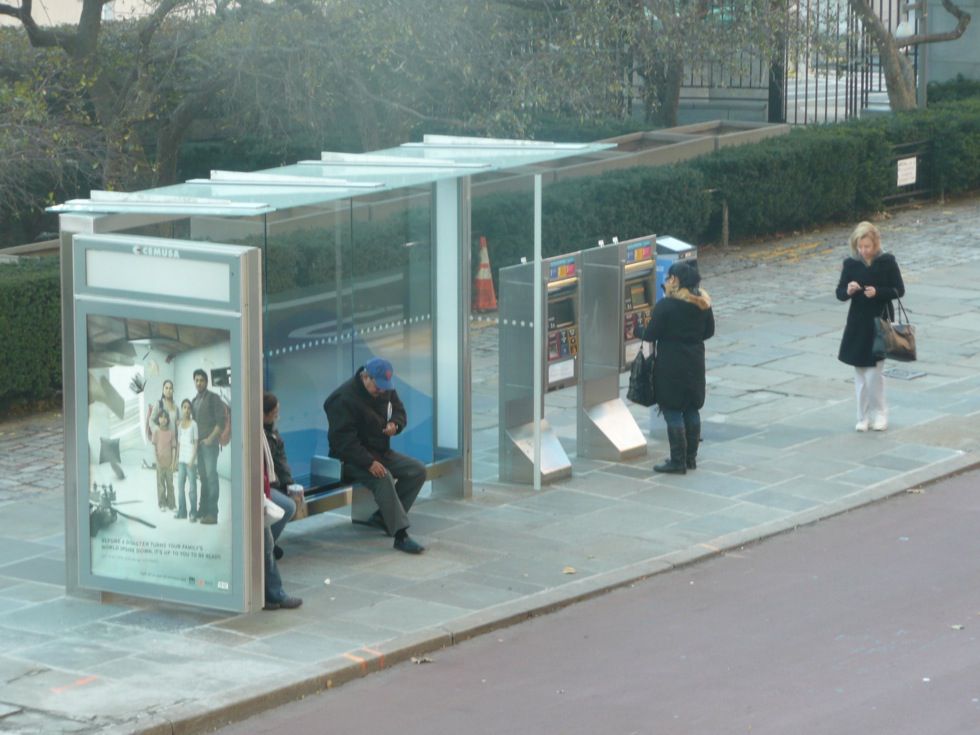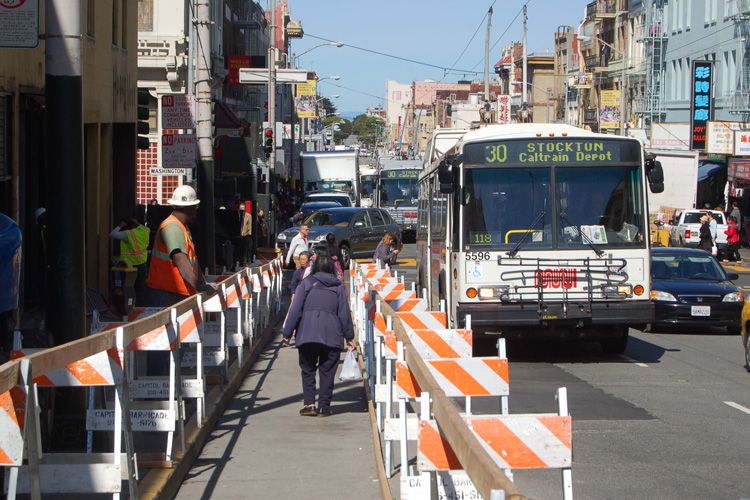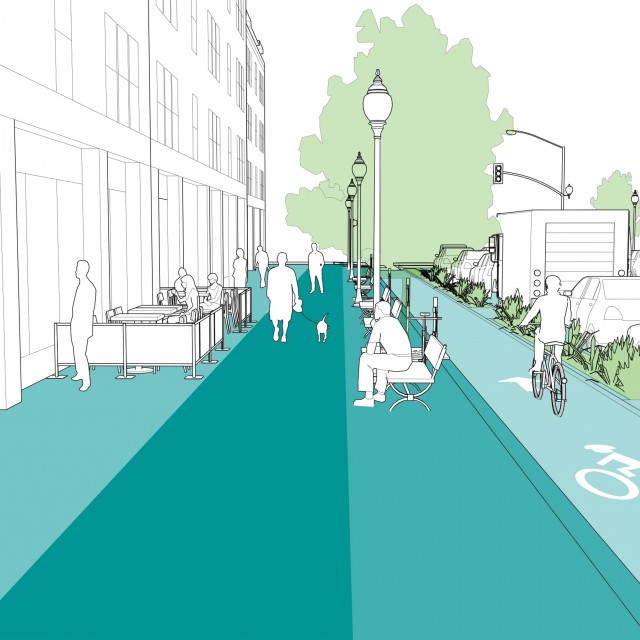
Sidewalks
Sidewalks play a vital role in city life. As conduits for pedestrian movement and access, they enhance connectivity and promote walking. As public spaces, sidewalks serve as the front steps to the city, activating streets socially and economically. Safe, accessible, and well-maintained sidewalks are a fundamental and necessary investment for cities, and have been found to enhance general public health and maximize social capital.
Just as roadway expansions and improvements have historically enhanced travel for motorists, superior sidewalk design can encourage walking by making it more attractive.






The sidewalk is the area where people interface with one another and with businesses most directly in an urban environment.
Sidewalk Zones
Frontage Zone
Pedestrian Through Zone
Street Furniture/Curb Zone
Enhancement/Buffer Zone
Sidewalk Design
Discussion
Critical
Recommended
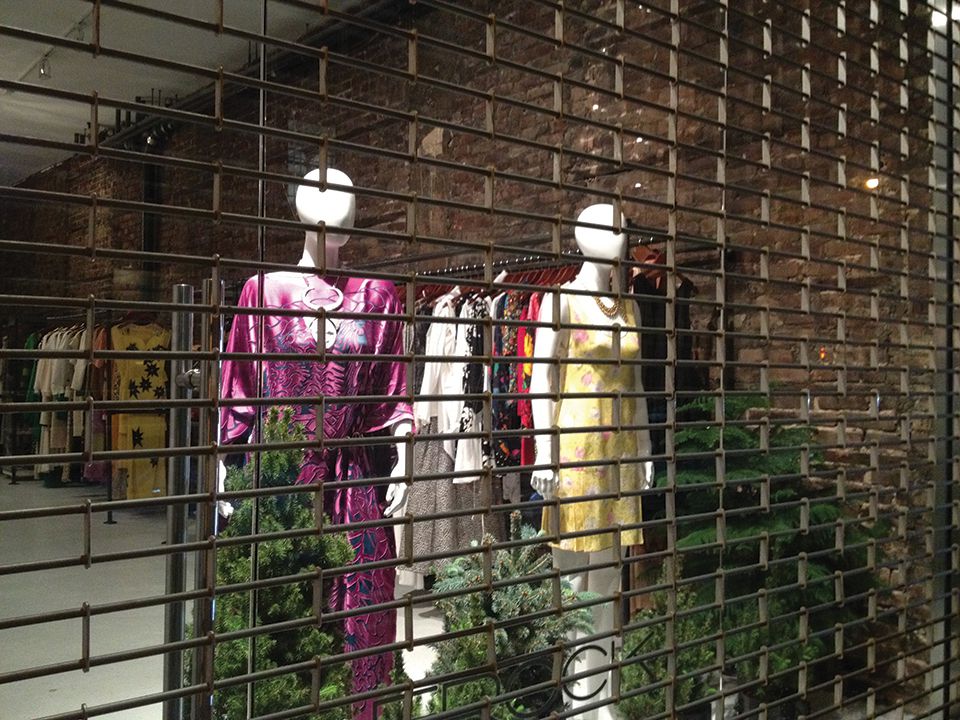
Façades and storefronts should be designed to cater to the eye level of pedestrians.
Strategies include:
- Lighting scaled to the pedestrian realm in addition to overhead lighting for vehicles.
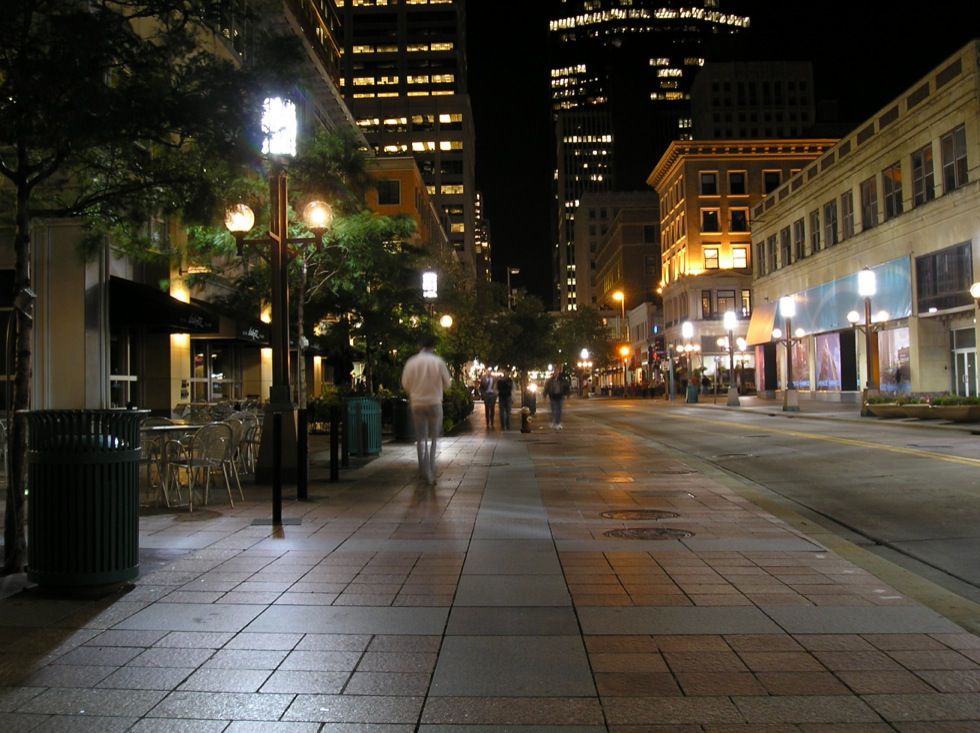 Location: Minneapolis, MN
Location: Minneapolis, MN
- Benches and other seating platforms designed into the structure itself or placed within the frontage zone.
- Incentives to provide awnings, sidewalk cafes, and other elements that improve the comfort and appearance of the sidewalk.
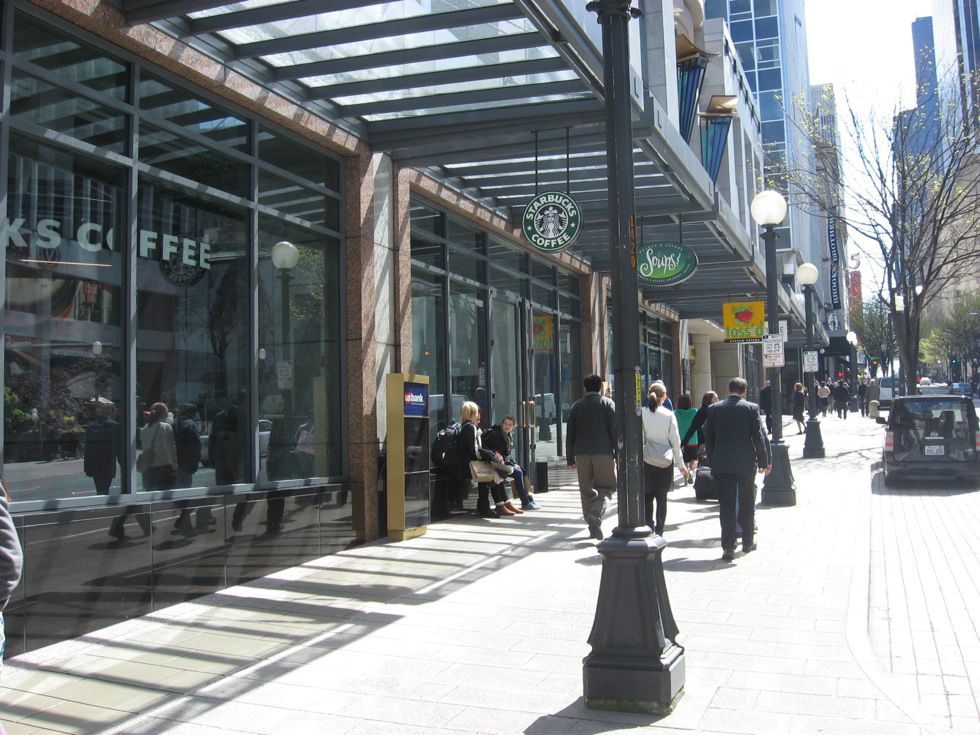
- Where security concerns are present, use of permeable, rather than closed, metal shutters on storefronts at night (above).
- Provision of adequate lighting beneath scaffolding and other construction sites.
Optional
Street Trees
Street trees enhance city streets both functionally and aesthetically. Trees provide shade to homes, businesses, and pedestrians. Street trees also have the potential to slow traffic speeds, especially when placed on a curb extension in line with on-street parking, and may increase pavement life by avoiding extreme heat. Aesthetically, street trees frame the street and the sidewalk as discrete public realms, enriching each with a sense of rhythm and human scale.
Requirements for tree spacing depend upon a number of key factors and should be tailored to the chosen species, standard (or desired) tree pit size, fixed property lines, setback from curb, and integration with street lights and other furniture.
Street trees may be removed to satisfy sight distance or clear zone requirements only in extreme cases, where the installation of traffic control devices has been precluded. Larger trees protect pedestrians from errant vehicles.
Clear Zones

 Clear zones are applicable on rural highways with high vehicle speeds, not in urban areas.
Clear zones are applicable on rural highways with high vehicle speeds, not in urban areas.
The concept of “clear zones” is sometimes cited in the highway design process. A clear zone represents an unobstructed, traversable area beyond the traveled way, often a paved or planted shoulder or a short setback on the sidewalk.9 Clear zones provide a run-off zone for errant vehicles that have deviated from the main roadway and are intended to decrease the frequency and severity of fixed-object roadside crashes, forgiving driver error.10
See Design Speed
While clear zones are applicable as a safety parameter for the Interstate and freeway system, in urban settings, delineation of a minimum set back from the curb is not a required element. To the greatest extent possible, the lateral distance between the traveled way and the sidewalk (or parking lane) should be minimized, providing ample space for sidewalks and other amenities.11
Removal of roadside impediments (trees, street furniture, etc.) has an ambiguous safety record in urban environments and is at odds with city policies striving to increase pedestrian traffic and spur economic activity. Street trees and other roadside features are superior to wide shoulders or run-off zones, as they can decrease overall speeds and encourage a more pedestrian-friendly environment.
Footnotes
- A 2003 newsletter of “Let’s Talk Business” cited several economic benefits of walkable communities, including a case study from Lodi, CA that cited how pedestrian improvements paired with economic development incentives dropped the retail vacancy rate from 18% to 6% and also resulted in a 30% increase in downtown sales tax revenues.
Bill Ryan, “Let’s Talk Business: Ideas for Expanding Retails and Services in Your Community,” UW Extension, July 2003.
A 2011 research study titled Examining Walkability and Social Capital as Indicators of Quality of Life at the Municipal and Neighborhood Scales used a case study approach between three communities in New Hampshire. Comparisons between the more walkable and less walkable neighborhoods show that levels of social capital are higher in more walkable neighborhoods.Shannon H. Rogers, John M. Halstead, Kevin M. Gardner, and Cynthia H. Carlson, “Examining Walkability and Social Capital as Indicators of Quality of Life at the Municipal and Neighborhood Scales,” Applied Research Quality of Life 6 (2010): 201–213.
- Examples of higher standards for sidewalks include downtown Washington, D.C. (16 foot + 6 foot buffer), Chicago (varies between 10–12 feet depending on context), San Francisco (9–17 feet depending on context), Boston (target varies, but minimum is 7 feet for several street types).
- As an example, Washington, D.C.’s Design Engineering Manual states that a sidewalk should exist on both sides of every street or roadway.
Design and Engineering Manual (Washington, D.C.: D.C. Department of Transportation, 2009): 29–3.
- Joe Cortright, Walking the Walk: How Walkability Raises Housing Values in U.S. Cities (Chicago: CEOs for Cities, 2009).
- Paul D. Thompson, Kevin M. Ford, Arman Mohammad, Samuel Labi, Arun Shirolé, and Kumares Siuha. NCHRP Report 713: Estimating Life Expectancies of Highway Assets. Volume 1: Guidebook. (Washington, D.C.: Transportation Research Board, 2012).
- Federal Highway Administration, “Sidewalk Corridor Width,” Designing Sidewalks and Trails for Access (Washington, D.C.: FHWA, 2001).
- According to the American Disabilities Act, the minimum sidewalk width at bus stop loading points should be 8 feet to ensure clear boarding and alighting. The location of a bus shelter, bench, or other permanent fixtures should ensure a 3-foot clear path for pedestrian travel. However, 3 feet is not the recommended width for sidewalks, it is the absolute minimum needed to ensure a clear path of travel when obstacles exist in the sidewalk.
Americans With Disabilities Act of 1990.
- “Where sidewalks are placed adjacent to the curb, the widths should be approximately 6 m [2 ft.] wider than the minimum required width. This additional width provides space for roadside hardware and snow storage outside the width needed by pedestrians.”
A Policy on Geometric Design of Highways and Streets, 4th Edition (Washington, D.C.: AASHTO, 2001).
- AASHTO’s Roadside Design Guide defines a “clear zone as the total roadside border area, starting at the edge of the traveled way, available for safe use by errant vehicles. This area may consist of a shoulder, a recoverable slope, a non-recoverable slope, and/or a clear run-out area.”
Roadside Design Guide, 4th Edition (Washington, D.C.: AASHTO, 2011).
- In urban areas, the presence of fixed roadside objects (such as trees) is correlated with lower crash frequencies. This suggests that roadside objects in urban areas may actually enhance safety (by increasing driver caution and reducing speeds). As referenced in Eric Dumbaugh, “Safe Streets, Livable Streets,” Journal of the American Planning Association 71 (2005): 295.
- The AASHTO Green Book suggests a minimum offset distance of 1.5 feet between the face of the curb to the nearest fixed object off the roadway.
A Policy on Geometric Design of Highways and Streets, 4th Edition (Washington, D.C.: AASHTO, 2001).
References
- Access Minneapolis. “Pedestrian Facility Design.” Design Guidelines for Streets and Sidewalks (2009): 10-1-10-60.
- American Association of State Highway and Transportation Officials. A Policy on Geometric Design of Highways and Streets. Washington, D.C.: 2001.
- American Association of State Highway and Transportation Officials. Roadside Design Guide. Washington D.C.: 2011.
- Axelson, Peter W., Denise A. Chesney. Dorothy V. Galvan, Julie B. Kirschbaum, Patricia E. Longmuir, Camille Lyons, and Kathleen M. Wong. “Designing Sidewalks and Trails for Access.” Part I of II: Review of Existing Guidelines and Practices (1999): (1), 1-184.
- Boodlal, Leverson. “Providing Accessible Sidewalks and Street Crossings.” Washington, D.C.: U.S. Department of Transportation, National Highway Administration, 2003.
- City of Richmond Department of Planning and Development. Sidewalk Café Design Guidelines. Richmond: 2012.
- Cortright, Joe. “Walking the Walk: How Walkability Raises Housing Values in U.S. Cities.” CEOs for Cities, Chicago, 2009.
- District Department of Transportation. Design Engineering Manual. Washington D.C.: 2009.
- Dixon, Karen K., Michael Liebler, Hong Zhu, Michael P. Hunter, and Berry Mattox. “Safe and Aesthetic Design of Urban Roadside Treatments.” Transportation Research Board NCHRP Report 612 (2008): 1-74.
- Dixon, Karen K., and Kathleen L. Wolf. "Benefits and risks of urban roadside landscape: finding a livable, balanced response." Prepared for the 3rd Urban Street Symposium: Uptown, Downtown, or Small Town: Designing Urban Streets That Work, Seattle, June 24-27, 2007.
- Dumbaugh, Eric. "Design of Safe Urban Roadsides: An Empirical Analysis." Transportation Research Record: Journal of the Transportation Research Board1961 (2006): (1), 74-82.
- Dumbaugh, Eric. “Safe Streets, Livable Streets.” Journal of the American Planning Association (2005): 71, 295.
- Kim, Sangyoup, Jaisung Choi, and Yongseok Kim. "Determining the Sidewalk Pavement Width by Using Pedestrian Discomfort Levels and Movement Characteristics." KSCE Journal of Civil Engineering (2011): 15(5), 883-889.
- Kirschbaum, Julie B., P. W. Axelson, P. E. Longmuir, K. M. Mispagel, J. A. Stein, and D. A. Yamada. “Designing Sidewalks and Trails for Access.” Part II of II: Best Practices Design Guide (2001): (1), 1-484.
- Loukaitou-Sideris, Anastasia, and Renia Ehrenfeucht. “Sidewalks: Conflict and Negotiation over Public Space.” Cambridge: Massachusetts Institute of Technology, 2009.
- Lowber, Kayla. “Outdoor Cafes/Widened Sidewalks.” Paris-Chamaps Elysses and Arc: 1-7.
- Minneapolis Coordinated Street Furniture. Program Guidelines Report. Minneapolis: 2007.
- Mok, Jeong-Hun, Harlow C. Landphair, and Jody R. Naderi. "Comparison of Safety Performance of Urban Streets Before and After Landscape Improvements." 2nd Urban Street Symposium (2003): (2), 1-17.
- Mok, Jeong-Hun, Harlow C. Landphair, and Jody R. Naderi. "Landscape Improvement Impacts on Roadside Safety in Texas." Landscape and Urban Planning (2006): 78(3), 263-274.
- New York City Department of City Planning. Active Design: Shaping the Sidewalk Experience. New York: 2013.
- Rogers, Shannon, John Halstead, Kevin Gardner, and Cynthia Carlson. “Examining Walkability and Social Capital as Indicators of Quality of Life at the Municipal and Neighborhood Scales.” Applied Research Quality Life (2011): 6, 201-213.
- Ryan, Bill, Steve Deller, and Gary Green. “Let’s Talk Business: Ideas for Expanding Retail and Services in your Community.” UW Extension (2003): 65, 1-2.
- San Francisco Department of Public Works. “Regulating The Planting, Maintenance, Or Removal Of Trees And Landscape Material On Public Sidewalk Areas And Superceding.” San Francisco: 2010.
- Sax, Christian R., Thomas H. Maze, Reginald R. Souleyrette, Neal Hawkins, and Alicia L. Carriquiry. “Optimum Urban Clear Zone Distance.” Transportation Research Record 2195 (2010): 27–35.
- Thompson, Paul, Kevin Ford, Mohammad Arman, Samuel Labi, Kumares Sinha, and Arun Shirole. “Estimating Life Expectancies of Highway Assets: Volume 1 Guidebook.” Transportation Research Board NCHRP Report 713 (2012): 1-150.
- Wolf, Kathleen L. "More in Store: Research on City Trees and Retail." Arborist New (2009): 18(2), 22-27.
Adapted from the Urban Street Design Guide, published by Island Press.
References
References for Sidewalks: 22 found.
- American Association of State Highway and Transportation Officials. "Roadside Design Guide, 4th Edition." American Association of State Highway and Transportation Officials, American Association of State Highway and Transportation Officials, Washington, DC.
- City of Minneapolis. "Access Minneapolis: Design Guidelines for Streets and Sidewalks." Public Works Department, City of Minneapolis, Minneapolis, MN.
- Boodlal, Leverson. "Accessible Sidewalks and Street Crossings — an informational guide." Federal Highway Administration, US Department of Transportation, Washington, DC.
- Duncan, Skye, Gabriela Callejas, Alexandra Gonzalez, Belinda Kanpetch, Parul Agarwala, & Jeff Shumaker. "Active Design: Shaping the Sidewalk Experience." Department of City Planning, City of New York, New York, NY.
- Storefront for Community Design. "Sidewalk Café Design Guidelines." Department of Planning & Development Review, City of Richmond, Richmond, VA.
- Mok, Jeong-Hun, Harlow C Landphair, & Jody R Naderi. "Comparison of Safety Performance of Urban Streets Before and After Landscape Improvements." 2nd Urban Street Symposium (2) 1-17, Transportation Research Board, Washington, DC.
- District Department of Transportation. "Design and Engineering Manual." District Department of Transportation, District of Columbia, Washington, DC.
- Dumbaugh, Eric. "Design of Safe Urban Roadsides: An Empirical Analysis." Journal of the Transportation Research Board, Transportation Research Board, Washington, DC.
- Axelson, Peter W, Denise A Chesney, Dorothy V Galvan, Julie B Kirschbaum, Patricia E Longmuir, Camille Lyons, & Kathleen M Wong,. "Designing Sidewalks and Trails for Access, Part I of II: Review of Existing Guidelines and Practices." Federal Highway Administration, US Department of Transportation, Washington, DC.
- Kirschbaum, Julie B, PW Axelson, PE Longmuir, KM Mispagel, JA Stein, & DA Yamada. "Designing Sidewalks and Trails for Access, Part II of II: Best Practices Design Guide." Bicycle & Pedestrian Section, Federal Highway Administration, Washington, DC.
- Kim, Sangyoup, Jaisung Choi, & Yongseok Kim. "Determining the Sidewalk Pavement Width by Using Pedestrian Discomfort Levels and Movement Characteristics." KSCE Journal of Civil Engineering 15(5), 883-889, Springer Science+Business Media, New York, NY.
- Thompson, Paul, Kevin Ford, Mohammad Arman, Samuel Labi, Kumares Sinha, & Arun Shirole. "Estimating Life Expectancies of Highway Assets: Volume 1 Guidebook." NCHRP Report 713 1-150, Transportation Research Board, Washington, DC.
- Rogers, Shannon, John Halstead, Kevin Gardner, and Cynthia Carlson. "Examining Walkability and Social Capital as Indicators of Quality of Life at the Municipal and Neighborhood Scales." Applied Research Quality Life 6, 201-213, Springer Science+Business Media, New York, NY.
- Ryan, Bill, Steve Deller, and Gary Green. "Let’s Talk Business: Ideas for Expanding Retail and Services in your Community." Center For Community Economic Development, University of Wisconsin Extension 65, 1-2, Madison, WI.
- Minneapolis Public Works. "Minneapolis Coordinated Street Furniture Program Guidelines Report." Department of Public Works, City of Minneapolis, MN, Minneapolis, MN.
- Wolf, Kathleen L. "More in Store: Research on City Trees and Retail." Arborist New 18(2), 22-27, International Society of Arboriculture, Champaign, IL.
- Sax, Christian R, Thomas H Maze, Reginald R Souleyrette, Neal Hawkins, & Alicia L Carriquiry. "Optimum Urban Clear Zone Distance." Transportation Research Record 2195, 27–35, Transportation Research Board, Washington, DC.
- Lowber, Kayla. "Outdoor Cafes/Widened Sidewalks." Department of Urban Design and Planning, University of Washington, Seattle, WA.
- Dixon, Karen K, Michael Liebler, Hong Zhu, Michael P. Hunter, & Berry Mattox. "Safe and Aesthetic Design of Urban Roadside Treatments." National Cooperative Highway Research Program, Transportation Research Board, Washington, DC.
- Reiskin, Edward D. "Regulating The Planting, Maintenance, Or Removal Of Trees And Landscape Material On Public Sidewalk Areas And Superceding." Department of Public Works, City & County of San Francisco, San Francisco, CA.
- Loukaitou-Sideris, Anastasia, & Renia Ehrenfeucht. "Sidewalks: Conflict and Negotiation over Public Space." Massachusetts Institute of Technology, The MIT Press, Cambridge, MA.
- Cortright, Joe. "Walking the Walk: How Walkability Raises Housing Values in U.S. Cities." Impresa, Inc., CEOs for Cities, Chicago, IL.


